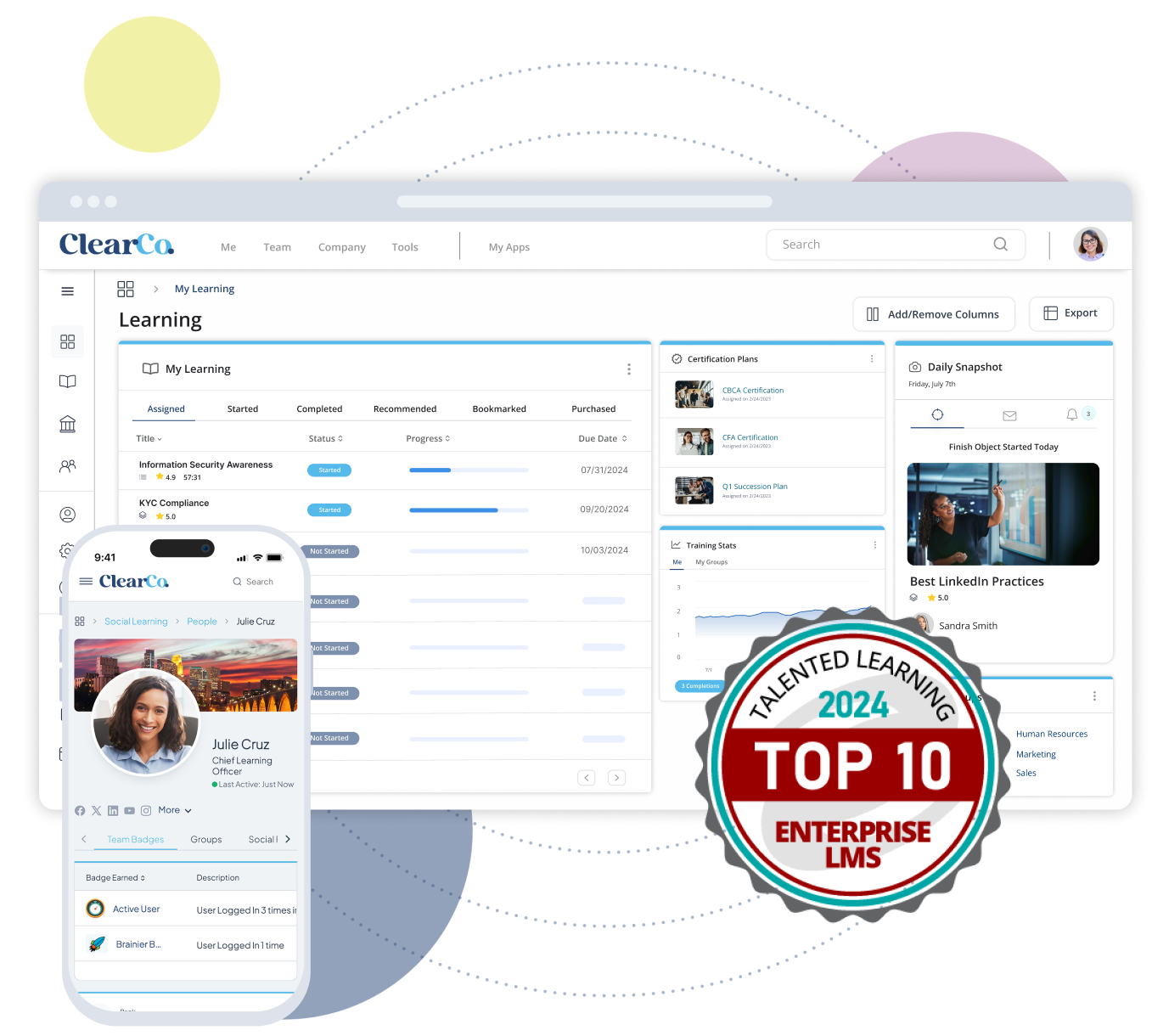Employee learning and development (L&D) is one of the most powerful strategies for boosting engagement, retention, and productivity. Despite its value, 60% of organizations say their L&D initiatives are not aligned with business goals. When employee training doesn’t support what the business needs, it’s hard to know if it’s working — and even harder to show leaders the value of learning.
This disconnect leads to big skill gaps. Research shows that 59% of employees will need new skills by 2030, but many don’t get enough training to keep up. To fix this, you need a smarter L&D plan that matches business goals and helps employees grow in ways that really matter.
Why L&D & Business Goals Should Align
Aligning learning initiatives with company goals is necessary if you want real results. When training programs focus on what the business needs, every dollar spent drives measurable improvements in productivity and performance. Companies with well-aligned L&D strategies are 122% more likely to meet or exceed their KPIs.
When learning objectives are directly connected to organizational performance, you can better target training, closing skills gaps fast and helping employees succeed. It also keeps learning relevant and engaging, which boosts motivation and helps retain top talent. 76% of workers say they’d stay longer if they had more learning opportunities — proof that developing employees’ skills is good for both your people and business outcomes.
L&D that supports business priorities helps employees understand how their growth contributes to the company’s success. If your L&D team can create that connection, you build a culture of continuous improvement and agile teams ready to tackle the challenges of today and tomorrow.
L&D Strategy Template: 6 Steps To Align L&D With Business Goals
If you’re ready to build a successful learning and development strategy that actually supports your business goals, follow a clear set of steps that keep your plan focused, measurable, and effective. Here’s a template to get you started — from identifying core objectives to using the right technology — so your learning programs drive real impact.
1. Identify Core Business Objectives
Before planning any learning programs, start by understanding what your business really needs to achieve. What are the company’s top goals this year? Are you focused on growing sales, improving customer service, launching new products, or cutting costs? Whatever your priorities, this will shape where L&D can have the biggest impact.
Knowing core business objectives helps you design training that supports those goals directly. Instead of creating generic, one-size-fits-all programs, focus on specific skills and knowledge that will move the business forward. Clear business performance goals also make it easier to measure success and prove if your learning efforts are paying off, which builds support from leaders.
Action Items for L&D Leaders
- Meet with business leaders to understand top priorities for the year across the org.
- Review recent business performance data to spot where improvements are needed.
- Communicate priorities with your L&D team to guide program design.
2. Conduct a Skills Gap Analysis
Once you know your business goals, the next step is to understand where your employees stand when it comes to the skills needed to reach those goals. A skills gap analysis helps you spot gaps between current skills and the skills required for success. This way, you can focus training efforts exactly where they’re needed and avoid wasting time on skills employees already have.
Skills gap analysis can be done through surveys, assessments, performance data, and feedback from managers. The results guide your learning programs and help prioritize which skills to develop first based on business impact. Employees are eager to do their part in closing the gap: 42% of all workers — 63% those under 24 — are currently looking for upskilling opportunities.
Action Items for L&D Leaders
- Collect data on current employee skills through assessments and manager input.
- Map these skills against the capabilities needed to meet your business objectives.
- Prioritize skill gaps to focus on those with the most impact on performance.
3. Partner With Key Stakeholders & Leadership
Designing an effective L&D program requires support and input from leaders and stakeholders across your organization. When leadership is involved early and often, training programs are more likely to align with real business needs and get the resources and attention they deserve. Building strong partnerships also helps spread the message that learning is a priority for the company.
Stakeholders can offer valuable insights about where the biggest skill gaps and business challenges lie. Their buy-in ensures L&D initiatives get the visibility and budget needed to succeed. Plus, managers who support learning help motivate employees to participate and apply new skills on the job.
Action Items for L&D Leaders
- Set up regular meetings with business leaders and key stakeholders to gather input and align on priorities.
- Communicate L&D goals and progress honestly and on a regular basis to leadership to maintain support.
- Train managers on how to encourage and reinforce learning within their teams.
4. Develop L&D Programs Around Measurable Outcomes
Once you’ve identified key skills gaps and gained input from stakeholders, it’s time to design learning programs with clear goals. Effective L&D programs focus on measurable outcomes that are directly related to business objectives. Instead of just tracking course completions, choose L&D KPIs tied to the behaviors or results the training should drive.
Set specific learning objectives and performance targets for each program. For example, if customer service is a priority, your training might aim to reduce call resolution times or increase customer satisfaction scores. When outcomes are measurable, you can track progress, adjust as needed, and show leadership the real impact of learning.
Action Items for L&D Leaders
- Define SMART learning objectives linked to business goals for each program.
- Design assessments and benchmarks that align with those objectives.
- Regularly review results and adjust programs based on data and feedback.
5. Integrate Learning Into Daily Workflows
For learning to truly stick and drive business results, it can’t be a time-consuming hassle. Learning needs to fit naturally into your employees’ workdays. When training feels like an extra task, it’s harder to get buy-in and see real change. Instead, weave learning opportunities directly into daily tasks, meetings, and projects.
You can do that by offering microlearning modules accessible on mobile, quick knowledge-sharing sessions during team meetings, or embedding learning resources in collaboration tools employees use every day. Making learning a regular, easy part of work boosts participation, skill application, and long-term retention.
Action Items for L&D Leaders
- Identify key moments in employees’ workflows where learning can be embedded without disruption.
- Use technology tools like mobile platforms and QR codes to deliver bite-sized microlearning on demand.
- Encourage managers to support and recognize learning activities as part of daily routines.
6. Utilize Learning Technology
Technology is a critical part of scaling and personalizing your learning programs. Modern AI-enhanced learning management systems (LMS) can automate skill gap analysis, personalize learning paths, and provide real-time data on learner progress and engagement. These tools help ensure employees get the right content at the right time, improving adoption and outcomes.
AI-powered LMS platforms can recommend courses based on job roles, learning history, and skill gaps. They also help L&D teams track impact and ROI more efficiently, making it easier to prove the value of your programs to leadership. Integrating your LMS with other HR systems ensures seamless data and workflows, and keeps your team running efficiently.
Action Items for L&D Leaders
- Evaluate LMS options with AI capabilities that fit your company’s size and learning needs.
- Look for an LMS that easily integrates with your other HR systems or that is part of a complete talent management system to streamline data flow.
- Train administrators and users on the system to maximize adoption and boost employee engagement.
Prove L&D Effectiveness With ClearCompany Learning
A modern LMS with reporting & analytics, like ClearCompany Learning, makes it easy to measure and share the impact of your L&D programs. With AI-powered insights, you can track skill growth, engagement, and real business outcomes — all in one place. This helps you prove the value of learning to leadership and keep improving your strategy.
Ready to see how ClearCompany Learning can help your team grow? Request a demo today and start turning learning into business results.



